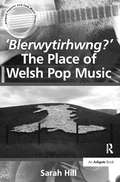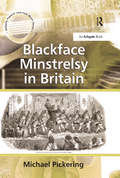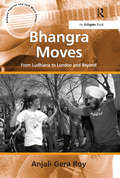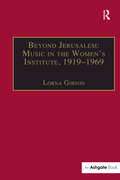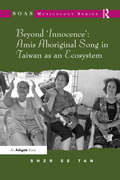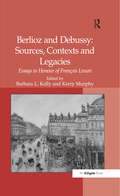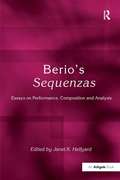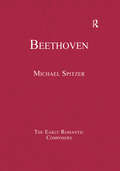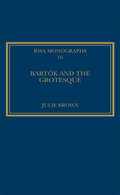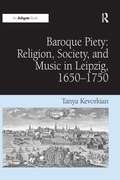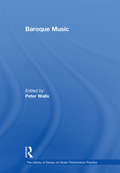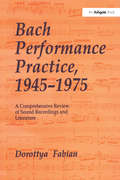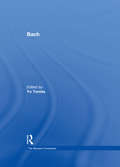- Table View
- List View
'Blerwytirhwng?' The Place of Welsh Pop Music
by Sarah HillIn the 1960s, Welsh-language popular music emerged as a vehicle for mobilizing a geographically dispersed community into political action. As the decades progressed, Welsh popular music developed beyond its acoustic folk roots, adopting the various styles of contemporary popular music, and ultimately gaining the cultural self-confidence to compete in the Anglo-American mainstream market. The resulting tensions, between Welsh and English, amateur and professional, rural and urban, the local and the international, necessitate the understanding of Welsh pop as part of a much larger cultural process. Not merely a 'Celtic' issue, the cultural struggles faced by Welsh speakers in a predominantly Anglophone environment are similar to those faced by innumerable other minority communities enduring political, social or linguistic domination. The aim of 'Blerwytirhwng?' The Place of Welsh Pop Music is to explore the popular music which accompanied those struggles, to connect Wales to the larger Anglo-American popular culture, and to consider the shift in power from the dominant to the minority, the centre to the periphery. By surveying the development of Welsh-language popular music from 1945-2000, 'Blerwytirhwng?' The Place of Welsh Pop examines those moments of crisis in Welsh cultural life which signalled a burgeoning sense of national identity, which challenged paradigms of linguistic belonging, and out of which emerged new expressions of Welshness.
'Blerwytirhwng?' The Place of Welsh Pop Music
by Sarah HillIn the 1960s, Welsh-language popular music emerged as a vehicle for mobilizing a geographically dispersed community into political action. As the decades progressed, Welsh popular music developed beyond its acoustic folk roots, adopting the various styles of contemporary popular music, and ultimately gaining the cultural self-confidence to compete in the Anglo-American mainstream market. The resulting tensions, between Welsh and English, amateur and professional, rural and urban, the local and the international, necessitate the understanding of Welsh pop as part of a much larger cultural process. Not merely a 'Celtic' issue, the cultural struggles faced by Welsh speakers in a predominantly Anglophone environment are similar to those faced by innumerable other minority communities enduring political, social or linguistic domination. The aim of 'Blerwytirhwng?' The Place of Welsh Pop Music is to explore the popular music which accompanied those struggles, to connect Wales to the larger Anglo-American popular culture, and to consider the shift in power from the dominant to the minority, the centre to the periphery. By surveying the development of Welsh-language popular music from 1945-2000, 'Blerwytirhwng?' The Place of Welsh Pop examines those moments of crisis in Welsh cultural life which signalled a burgeoning sense of national identity, which challenged paradigms of linguistic belonging, and out of which emerged new expressions of Welshness.
Blackface Minstrelsy in Britain
by Michael PickeringBlackface minstrelsy is associated particularly with popular culture in the United States and Britain, yet despite the continual two-way flow of performers, troupes and companies across the Atlantic, there is little in Britain to match the scholarship of blackface studies in the States. This book concentrates on the distinctively British trajectory of minstrelsy. The historical study and cultural analysis of minstrelsy is important because of the significant role it played in Britain as a form of song, music and theatrical entertainment. Minstrelsy had a marked impact on popular music, dance and other aspects of popular culture, both in Britain and the United States. Its impact in the United States fed into significant song and music genres that were assimilated in Britain, from ragtime and jazz onwards, but prior to these influences, minstrelsy in Britain developed many distinct features and was adapted to operate within various conventions, themes and traditions in British popular culture. Pickering provides a convincing counter-argument to the assumption among writers in the United States that blackface was exclusively American and its British counterpart purely imitative. Minstrelsy was not confined to its value as song, music and dance. Jokes at the expense of black people along with demeaning racial stereotypes were integral to minstrel shows. As a form of popular entertainment, British minstrelsy created a cultural low-Other that offered confirmation of white racial ascendancy and imperial dominion around the world. The book attends closely to how this influence on colonialism and imperialism operated and proved ideologically so effective. At the same time British minstrelsy cannot be reduced to its racist and imperialist connections. Enormously important as those connections are, Pickering demonstrates the complexity of the subject by insisting that the minstrel show and minstrel performers are understood also in terms of their own theatrical dynamics, t
Blackface Minstrelsy in Britain
by Michael PickeringBlackface minstrelsy is associated particularly with popular culture in the United States and Britain, yet despite the continual two-way flow of performers, troupes and companies across the Atlantic, there is little in Britain to match the scholarship of blackface studies in the States. This book concentrates on the distinctively British trajectory of minstrelsy. The historical study and cultural analysis of minstrelsy is important because of the significant role it played in Britain as a form of song, music and theatrical entertainment. Minstrelsy had a marked impact on popular music, dance and other aspects of popular culture, both in Britain and the United States. Its impact in the United States fed into significant song and music genres that were assimilated in Britain, from ragtime and jazz onwards, but prior to these influences, minstrelsy in Britain developed many distinct features and was adapted to operate within various conventions, themes and traditions in British popular culture. Pickering provides a convincing counter-argument to the assumption among writers in the United States that blackface was exclusively American and its British counterpart purely imitative. Minstrelsy was not confined to its value as song, music and dance. Jokes at the expense of black people along with demeaning racial stereotypes were integral to minstrel shows. As a form of popular entertainment, British minstrelsy created a cultural low-Other that offered confirmation of white racial ascendancy and imperial dominion around the world. The book attends closely to how this influence on colonialism and imperialism operated and proved ideologically so effective. At the same time British minstrelsy cannot be reduced to its racist and imperialist connections. Enormously important as those connections are, Pickering demonstrates the complexity of the subject by insisting that the minstrel show and minstrel performers are understood also in terms of their own theatrical dynamics, t
Bhangra Moves: From Ludhiana to London and Beyond
by AnjaliGera RoyBhangra is commonly understood as the hybrid music produced in Britain by British Asian music producers through mixing Panjabi folk melodies with western pop and black dance rhythms. This is derived from a Punjabi harvest dance of the same name. This book looks at Bhangra's global flows from one of its originary sites, the Indian subcontinent, to contribute to the understanding of emerging South Asian cultural practices such as Bhangra or Bollywood in multi-ethnic societies. It seeks to trace Bhangra's moves from Punjab and its 'return back' to look at the forces that initiate and regulate global flows of local texts and to ask how their producers and consumers redirect them to produce new definitions of culture, identity and nation. The critical importance of this book lies in understanding the difference between the present globalizing wave and previous trans-local movements. Gera Roy contrasts the frames of cultural imperialism with those of cultural invasion to show how Indian cultures have constantly reinvented themselves by cross-pollinating with 'invading' cultures such as Hellenic, Persian, Arabic and many others in the past. By looking at Bhangra's flows to and from India, the book revises the relation between culture, space and identity and challenges boundaries. It weighs both the uses and costs of visibility provided by global networks to marginalized groups in diverse localities and explores whether collaborations between Bhangra practitioners, largely of working class origin, give ordinary people any control over the circulation of culture in the global village. Finally, the book considers whether cultural practices can alter hierarchies and power structures in the real world.
Bhangra Moves: From Ludhiana to London and Beyond
by AnjaliGera RoyBhangra is commonly understood as the hybrid music produced in Britain by British Asian music producers through mixing Panjabi folk melodies with western pop and black dance rhythms. This is derived from a Punjabi harvest dance of the same name. This book looks at Bhangra's global flows from one of its originary sites, the Indian subcontinent, to contribute to the understanding of emerging South Asian cultural practices such as Bhangra or Bollywood in multi-ethnic societies. It seeks to trace Bhangra's moves from Punjab and its 'return back' to look at the forces that initiate and regulate global flows of local texts and to ask how their producers and consumers redirect them to produce new definitions of culture, identity and nation. The critical importance of this book lies in understanding the difference between the present globalizing wave and previous trans-local movements. Gera Roy contrasts the frames of cultural imperialism with those of cultural invasion to show how Indian cultures have constantly reinvented themselves by cross-pollinating with 'invading' cultures such as Hellenic, Persian, Arabic and many others in the past. By looking at Bhangra's flows to and from India, the book revises the relation between culture, space and identity and challenges boundaries. It weighs both the uses and costs of visibility provided by global networks to marginalized groups in diverse localities and explores whether collaborations between Bhangra practitioners, largely of working class origin, give ordinary people any control over the circulation of culture in the global village. Finally, the book considers whether cultural practices can alter hierarchies and power structures in the real world.
Beyond Jerusalem: Music in the Women's Institute, 1919-1969
by Lorna GibsonMusic in the Women's Institute has become stereotyped by the ritualistic singing of Jerusalem at monthly meetings. Indeed, Jerusalem has had an important role within the organization, and provides a valuable means within which to assess the organization's relationship with women's suffrage and the importance of rurality in the Women's Institute's identity. However, this book looks beyond Jerusalem by examining the full range of music making within the organization and locates its significance within a wider historical-cultural context. The Institute's promotion of conducting - a regular part of its musical activity since the 1930s - is discussed within the context of embodying overtly feminist sentiments. Lorna Gibson concludes that a redefinition of the term 'feminism' is needed and the concept of 'gendered spheres' of conducting provides a useful means of understanding the Institute's policy. The organization's promotion of folk song is also examined and reveals the Institute's contribution to the Folk Revival, as well as providing a valuable context within which to understand the National Federation's first music commission, Ralph Vaughan Williams's Folk Songs of the Four Seasons (1950). This work, and the Institute's second commission, Malcolm Williamson's The Brilliant and the Dark (1969), are examined with the context of the organization's music policy. In addition to discussing the background to the works, issues of critical reception are addressed. The book concludes with an Epilogue about the National Society Choir (later known as the Avalon Singers), which tested the organization's commitment to amateur music making. The book is the result of meticulous work undertaken in the archives of the National Federation, the BBC Written Archives Centre, the V&A archives, the Britten-Pears Library, the Ralph Vaughan Williams Library, the Women's Library and the Newspaper Library.
Beyond Jerusalem: Music in the Women's Institute, 1919-1969
by Lorna GibsonMusic in the Women's Institute has become stereotyped by the ritualistic singing of Jerusalem at monthly meetings. Indeed, Jerusalem has had an important role within the organization, and provides a valuable means within which to assess the organization's relationship with women's suffrage and the importance of rurality in the Women's Institute's identity. However, this book looks beyond Jerusalem by examining the full range of music making within the organization and locates its significance within a wider historical-cultural context. The Institute's promotion of conducting - a regular part of its musical activity since the 1930s - is discussed within the context of embodying overtly feminist sentiments. Lorna Gibson concludes that a redefinition of the term 'feminism' is needed and the concept of 'gendered spheres' of conducting provides a useful means of understanding the Institute's policy. The organization's promotion of folk song is also examined and reveals the Institute's contribution to the Folk Revival, as well as providing a valuable context within which to understand the National Federation's first music commission, Ralph Vaughan Williams's Folk Songs of the Four Seasons (1950). This work, and the Institute's second commission, Malcolm Williamson's The Brilliant and the Dark (1969), are examined with the context of the organization's music policy. In addition to discussing the background to the works, issues of critical reception are addressed. The book concludes with an Epilogue about the National Society Choir (later known as the Avalon Singers), which tested the organization's commitment to amateur music making. The book is the result of meticulous work undertaken in the archives of the National Federation, the BBC Written Archives Centre, the V&A archives, the Britten-Pears Library, the Ralph Vaughan Williams Library, the Women's Library and the Newspaper Library.
Beyond 'Innocence': Amis Aboriginal Song in Taiwan as an Ecosystem
by ShzrEe TanTaiwan aboriginal song has received extensive media coverage since the launch and settlement of a copyright lawsuit following pop group Enigma's allegedly unauthorized use of Amis voices in the 1996 Olympics hit, Return To Innocence. Taking as her starting point the ripple effects of this case, Shzr Ee Tan explores the relationship of this song culture to contemporary Amis society. She presents Amis song in its multiple manifestations as an ecosystem, symbiotic components of which interact and feed back upon one another in cross-cutting platforms of village life, festival celebration, cultural performance, popular song, art music and Christian hymnody. Tan's investigation hinges upon drawing a conceptual line between ladhiw, the Amis term for 'song' - a word vested with connotations of life-force, tradition, ritual and taboo - and the foreign term of yinyue ('music' - borrowed from Mandarin). This difference forms the basis of how Amis song is (re)constructed through processes of modernization, Christianization and politico-economic change. A single Amis melody, for example, can exist in several guises that are contextually exclusive but functionally mutually-supportive. Thus, a weeding song (ladhiw), which may have lost its traditional context of existence following advancements in farming technology, becomes sustained within a larger ecosystem, finding new life on the interacting platforms of Amis Catholic hymnody, karaoke and tourist shows. The latter genres (collectively, yinyue) may not rely on traditional livelihoods for survival, but thrive on a traditional melody's deeper associations to local memory and idealized Amis identities. While these new and old genres are stylistically separate, they feed into each other and back into themselves - through transforming contexts and cross-referenced memes - in organic and developing cycles of song activity. Drawing from fieldwork conducted from 2000-2010 as well as a background in ethnomusicology and journalism, Ta
Beyond 'Innocence': Amis Aboriginal Song in Taiwan as an Ecosystem
by ShzrEe TanTaiwan aboriginal song has received extensive media coverage since the launch and settlement of a copyright lawsuit following pop group Enigma's allegedly unauthorized use of Amis voices in the 1996 Olympics hit, Return To Innocence. Taking as her starting point the ripple effects of this case, Shzr Ee Tan explores the relationship of this song culture to contemporary Amis society. She presents Amis song in its multiple manifestations as an ecosystem, symbiotic components of which interact and feed back upon one another in cross-cutting platforms of village life, festival celebration, cultural performance, popular song, art music and Christian hymnody. Tan's investigation hinges upon drawing a conceptual line between ladhiw, the Amis term for 'song' - a word vested with connotations of life-force, tradition, ritual and taboo - and the foreign term of yinyue ('music' - borrowed from Mandarin). This difference forms the basis of how Amis song is (re)constructed through processes of modernization, Christianization and politico-economic change. A single Amis melody, for example, can exist in several guises that are contextually exclusive but functionally mutually-supportive. Thus, a weeding song (ladhiw), which may have lost its traditional context of existence following advancements in farming technology, becomes sustained within a larger ecosystem, finding new life on the interacting platforms of Amis Catholic hymnody, karaoke and tourist shows. The latter genres (collectively, yinyue) may not rely on traditional livelihoods for survival, but thrive on a traditional melody's deeper associations to local memory and idealized Amis identities. While these new and old genres are stylistically separate, they feed into each other and back into themselves - through transforming contexts and cross-referenced memes - in organic and developing cycles of song activity. Drawing from fieldwork conducted from 2000-2010 as well as a background in ethnomusicology and journalism, Ta
Berlioz and Debussy: Essays in Honour of Fran-s Lesure
by Kerry MurphyThis collection of essays by scholars of nineteenth- and early twentieth-century French music has been assembled in homage to the influential and inspirational French musicologist Fran‘s Lesure who died in 2001. Lesure's immense erudition was legendary and spanned music from the sixteenth to the twentieth century. Two French composers who were particular foci in his scholarship were Berlioz and Debussy and this collection is based on scholarship around these two composers and the sources, contexts and legacies relating to their work.
Berlioz and Debussy: Essays in Honour of Fran-s Lesure
by Kerry MurphyThis collection of essays by scholars of nineteenth- and early twentieth-century French music has been assembled in homage to the influential and inspirational French musicologist Fran‘s Lesure who died in 2001. Lesure's immense erudition was legendary and spanned music from the sixteenth to the twentieth century. Two French composers who were particular foci in his scholarship were Berlioz and Debussy and this collection is based on scholarship around these two composers and the sources, contexts and legacies relating to their work.
Berio's Sequenzas: Essays on Performance, Composition and Analysis
by Maureen Ep Janet K. HalfyardBetween 1958 and 2002, Luciano Berio wrote fourteen pieces entitled Sequenza, along with several versions of the same work for different instruments, revisions of the original pieces and also the parallel Chemins series, where one of the Sequenzas is used as the basis for a new composition on a larger scale. The Sequenza series is one of the most remarkable achievements of the late twentieth century - a collection of virtuoso pieces that explores the capabilities of a solo instrument and its player, making extreme technical demands of the performer whilst developing the musical vocabulary of the instrument in compositions so assured and so distinctive that each piece both initiates and potentially exhausts the repertoire of a new genre. The Sequenzas have significantly influenced the development of composition for solo instruments and voice, and there is no comparable series of works in the output of any other composer. Series of pieces tend to be linked by the instruments for which the composer writes, but this is a series in which the pieces are linked instead by the variety of instruments for which Berio composed. The varied approaches taken by the contributors in discussing the pieces demonstrate the richness of this repertoire and the many levels on which Berio and these landmark compositions can be considered. Contributions are arranged under three main headings: Performance Issues; Berio's Compositional Process and Aesthetics; and Analytical Approaches.
Berio's Sequenzas: Essays on Performance, Composition and Analysis
by JanetK. HalfyardBetween 1958 and 2002, Luciano Berio wrote fourteen pieces entitled Sequenza, along with several versions of the same work for different instruments, revisions of the original pieces and also the parallel Chemins series, where one of the Sequenzas is used as the basis for a new composition on a larger scale. The Sequenza series is one of the most remarkable achievements of the late twentieth century - a collection of virtuoso pieces that explores the capabilities of a solo instrument and its player, making extreme technical demands of the performer whilst developing the musical vocabulary of the instrument in compositions so assured and so distinctive that each piece both initiates and potentially exhausts the repertoire of a new genre. The Sequenzas have significantly influenced the development of composition for solo instruments and voice, and there is no comparable series of works in the output of any other composer. Series of pieces tend to be linked by the instruments for which the composer writes, but this is a series in which the pieces are linked instead by the variety of instruments for which Berio composed. The varied approaches taken by the contributors in discussing the pieces demonstrate the richness of this repertoire and the many levels on which Berio and these landmark compositions can be considered. Contributions are arranged under three main headings: Performance Issues; Berio's Compositional Process and Aesthetics; and Analytical Approaches.
Beethoven: Adorno And Beethoven's Late Style (The\early Romantic Composers Ser.)
by Michael SpitzerOur image of Beethoven has been transformed by the research generated by a succession of scholars and theorists who blazed new trails from the 1960s onwards. This collection of articles written by leading Beethoven scholars brings together strands of this mainly Anglo-American research over the last fifty years and addresses a range of key issues. The volume places Beethoven scholarship within a historical and contemporary context and considers the future of Beethoven studies.
Beethoven
by Michael SpitzerOur image of Beethoven has been transformed by the research generated by a succession of scholars and theorists who blazed new trails from the 1960s onwards. This collection of articles written by leading Beethoven scholars brings together strands of this mainly Anglo-American research over the last fifty years and addresses a range of key issues. The volume places Beethoven scholarship within a historical and contemporary context and considers the future of Beethoven studies.
Bartók and the Grotesque: Studies in Modernity, the Body and Contradiction in Music
by Julie BrownThe grotesque is one of art's most puzzling figures - transgressive, comprising an unresolveable hybrid, generally focussing on the human body, full of hyperbole, and ultimately semantically deeply puzzling. In Bluebeard's Castle (1911), The Wooden Prince (1916/17), The Miraculous Mandarin (1919/24, rev. 1931) and Cantata Profana (1930), Bart ngaged scenarios featuring either overtly grotesque bodies or closely related transformations and violations of the body. In a number of instrumental works he also overtly engaged grotesque satirical strategies, sometimes - as in Two Portraits: 'Ideal' and 'Grotesque' - indicating this in the title. In this book, Julie Brown argues that Bart concerns with stylistic hybridity (high-low, East-West, tonal-atonal-modal), the body, and the grotesque are inter-connected. While Bart eveloped each interest in highly individual ways, and did so separately to a considerable extent, the three concerns remained conceptually interlinked. All three were thoroughly implicated in cultural constructions of the Modern during the period in which Bart as composing.
Bartók and the Grotesque: Studies in Modernity, the Body and Contradiction in Music
by Julie BrownThe grotesque is one of art's most puzzling figures - transgressive, comprising an unresolveable hybrid, generally focussing on the human body, full of hyperbole, and ultimately semantically deeply puzzling. In Bluebeard's Castle (1911), The Wooden Prince (1916/17), The Miraculous Mandarin (1919/24, rev. 1931) and Cantata Profana (1930), Bart ngaged scenarios featuring either overtly grotesque bodies or closely related transformations and violations of the body. In a number of instrumental works he also overtly engaged grotesque satirical strategies, sometimes - as in Two Portraits: 'Ideal' and 'Grotesque' - indicating this in the title. In this book, Julie Brown argues that Bart concerns with stylistic hybridity (high-low, East-West, tonal-atonal-modal), the body, and the grotesque are inter-connected. While Bart eveloped each interest in highly individual ways, and did so separately to a considerable extent, the three concerns remained conceptually interlinked. All three were thoroughly implicated in cultural constructions of the Modern during the period in which Bart as composing.
Baroque Piety: Religion, Society, and Music in Leipzig, 1650-1750
by Tanya KevorkianDrawing upon a rich array of sources from archives in Leipzig, Dresden and Halle, Tanya Kevorkian illuminates culture in Leipzig before and during J.S. Bach's time in the city. Working with these sources, she has been able to reconstruct the contexts of Baroque and Pietist cultures at key periods in their development much more specifically than has been done previously. Kevorkian shows that high Baroque culture emerged through a combination of traditional frameworks and practices, and an infusion of change that set in after 1680. Among other forms of change, new secular arenas appeared, influencing church music and provoking reactions from Pietists, who developed alternative meeting, networking and liturgical styles. The book focuses on the everyday practices and active roles of audiences in public religious life. It examines music performance and reception from the perspectives of both 'ordinary' people and elites. Church services are studied in detail, providing a broad sense of how people behaved and listened to the music. Kevorkian also reconstructs the world of patronage and power of city councillors and clerics as they interacted with other Leipzig inhabitants, thereby illuminating the working environment of J.S. Bach, Telemann and other musicians. In addition, Kevorkian reconstructs the social history of Pietists in Leipzig from 1688 to the 1730s.
Baroque Piety: Religion, Society, and Music in Leipzig, 1650-1750
by Tanya KevorkianDrawing upon a rich array of sources from archives in Leipzig, Dresden and Halle, Tanya Kevorkian illuminates culture in Leipzig before and during J.S. Bach's time in the city. Working with these sources, she has been able to reconstruct the contexts of Baroque and Pietist cultures at key periods in their development much more specifically than has been done previously. Kevorkian shows that high Baroque culture emerged through a combination of traditional frameworks and practices, and an infusion of change that set in after 1680. Among other forms of change, new secular arenas appeared, influencing church music and provoking reactions from Pietists, who developed alternative meeting, networking and liturgical styles. The book focuses on the everyday practices and active roles of audiences in public religious life. It examines music performance and reception from the perspectives of both 'ordinary' people and elites. Church services are studied in detail, providing a broad sense of how people behaved and listened to the music. Kevorkian also reconstructs the world of patronage and power of city councillors and clerics as they interacted with other Leipzig inhabitants, thereby illuminating the working environment of J.S. Bach, Telemann and other musicians. In addition, Kevorkian reconstructs the social history of Pietists in Leipzig from 1688 to the 1730s.
Baroque Music
by Peter WallsResearch in the 20th and 21st centuries into historical performance practice has changed not just the way performers approach music of the 17th and 18th centuries but, eventually, the way audiences listen to it. This volume, beginning with a 1915 Saint-Sa lecture on the performance of old music, sets out to capture musicological discussion that has actually changed the way Baroque music can sound. The articles deal with historical instruments, pitch, tuning, temperament, the nexus between technique and style, vibrato, the performance implications of musical scores, and some of the vexed questions relating to rhythmic alteration. It closes with a section on the musicological challenges to the ideology of the early music movement mounted (principally) in the 1990s. Leading writers on historical performance practice are represented. Recognizing that significant developments in historically-inspired performance have been led by instrument makers and performers, the volume also contains representative essays by key practitioners.
Baroque Music
by Peter WallsResearch in the 20th and 21st centuries into historical performance practice has changed not just the way performers approach music of the 17th and 18th centuries but, eventually, the way audiences listen to it. This volume, beginning with a 1915 Saint-Sa lecture on the performance of old music, sets out to capture musicological discussion that has actually changed the way Baroque music can sound. The articles deal with historical instruments, pitch, tuning, temperament, the nexus between technique and style, vibrato, the performance implications of musical scores, and some of the vexed questions relating to rhythmic alteration. It closes with a section on the musicological challenges to the ideology of the early music movement mounted (principally) in the 1990s. Leading writers on historical performance practice are represented. Recognizing that significant developments in historically-inspired performance have been led by instrument makers and performers, the volume also contains representative essays by key practitioners.
Bach Performance Practice, 1945-1975: A Comprehensive Review of Sound Recordings and Literature
by Dorottya FabianAnalysing over 100 recordings from 1945-1975, this book examines twentieth-century baroque performance practice as evinced in all the commercially available recordings of J.S. Bach's Passions, Brandenburg Concertos and Goldberg Variations. Dorottya Fabian presents a qualitative, style-orientated history of the early music movement in its formative years through a comparison of the performance style heard in these recordings with the scholarly literature on Bach performance practice. Issues explored in the book include the availability of resources, balance, tempo, dynamics, ornamentation, rhythm and articulation. During the decades following the Second World War, the early music movement was more concerned with the revival of repertoire than with the revival of performance style which meant that its characteristics and achievements differed essentially from those of the later 1970s and 1980s. Period practice techniques were not practised even by ensembles using eighteenth-century instruments. Yet, as this survey reveals, several recordings of the period provide unexpectedly stylish interpretations using metre and pulse to punctuate the music. Such metric performance and appropriate articulation helped to clarify structure and texture and assisted in the creation of a musical discourse - the pre-eminent goal of baroque compositions.
Bach Performance Practice, 1945-1975: A Comprehensive Review of Sound Recordings and Literature
by Dorottya FabianAnalysing over 100 recordings from 1945-1975, this book examines twentieth-century baroque performance practice as evinced in all the commercially available recordings of J.S. Bach's Passions, Brandenburg Concertos and Goldberg Variations. Dorottya Fabian presents a qualitative, style-orientated history of the early music movement in its formative years through a comparison of the performance style heard in these recordings with the scholarly literature on Bach performance practice. Issues explored in the book include the availability of resources, balance, tempo, dynamics, ornamentation, rhythm and articulation. During the decades following the Second World War, the early music movement was more concerned with the revival of repertoire than with the revival of performance style which meant that its characteristics and achievements differed essentially from those of the later 1970s and 1980s. Period practice techniques were not practised even by ensembles using eighteenth-century instruments. Yet, as this survey reveals, several recordings of the period provide unexpectedly stylish interpretations using metre and pulse to punctuate the music. Such metric performance and appropriate articulation helped to clarify structure and texture and assisted in the creation of a musical discourse - the pre-eminent goal of baroque compositions.
Bach
by Yo TomitaFor nearly two centuries Johann Sebastian Bach has been regarded as a cornerstone of Western musical culture. His music inspired subsequent generations of composers and philosophers alike, and continues to capture our imaginations in many ways. Bach studies is part of this picture, often seen as providing excellent examples of musicological scholarship. The volume editor has chosen thirty-one published articles which, in his view, not only represent a broad spectrum of the scholarly discussions on Bach's life and works, but will also facilitate the on-going study of Bach's creative genius. The articles have been selected to ensure that this volume will be considered useful for not only those students who are currently engaging in Bach studies at universities but also for more seasoned Bach scholars as they consider the future direction of Bach studies.
